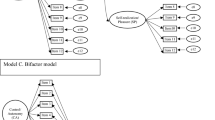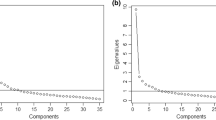Abstract
Purpose
This study aims to evaluate the validity of current measurement models for the control, autonomy, self-realisation, and pleasure (CASP) measure of quality of life (QoL)—a second-order four-factor CASP-19 model and a second-order three-factor CASP-12 version—in a recent population survey. A previous large sample study did not report good fit for these measurement models. The study also aims to re-develop the model and propose a well-fitting alternative.
Methods
To evaluate the current measurement models, confirmatory factor analysis (CFA) was used. A cross-sectional sample (n = 6,823) representative of the Irish community-dwelling population aged 50 and over was obtained from the Irish Longitudinal Study of Ageing (TILDA). Model revision was based on descriptive statistics, exploratory factor analysis and examination of fit diagnostic statistics. Revised models were tested using CFA.
Results
The results of the CFA did not support the validity of the established measurement models. A reformulated 12-item, two-factor model comprising control/autonomy and self-realisation/pleasure, with residual covariances for negatively worded items, had excellent fit to the data (χ2 161.90, df = 44, p < 0.001; RMSEA = 0.03, 90 % CI 0.02–0.03), and a clearer conceptual rationale. The same model with one overall QoL factor had similar excellent fit.
Conclusions
We recommend the use of the single-factor model (CASP-R12) when assessing overall quality of life. The dimensions of control/autonomy and self-realisation/pleasure can be examined separately by researchers interested in those constructs. Researchers using structural equation modelling can use the well-fitting measurement model outlined here including adjustment for residual covariances.

Similar content being viewed by others
References
Hickey, A., Barker, M., McGee, H., & O’Boyle, C. (2005). Measuring health-related quality of life in older patient populations: A review of current approaches. PharmacoEconomics, 23(10), 971–993.
Moons, P., Budts, W., & De Geest, S. (2006). Critique on the conceptualisation of quality of life: A review and evaluation of different conceptual approaches. International Journal of Nursing Studies, 43(7), 891–901.
Higgs, P., Hyde, M., Wiggins, R., & Blane, D. (2003). Researching quality of life in early old age: The importance of the sociological dimension. Social Policy & Administration, 37(3), 239–252.
Hyde, M., Wiggins, R. D., Higgs, P., & Blane, D. B. (2003). A measure of quality of life in early old age : The theory, development and properties of a needs satisfaction model (CASP-19). Ageing and Mental Health, 7(3), 186–194.
Maslow, A. H. (1968). Toward a psychology of being (2nd ed.). Princeton, NJ: Van Nostrand.
Doyal, L., & Gough, I. (1991). A theory of human need. Basingstoke, Hampshire: Macmillan Education Ltd.
Laslett, P. (1991). A fresh map of life: The emergence of the third age (2nd ed.). Basingstoke, Hampshire: Macmillan Press Ltd.
Giddens, A. (1990). The consequences of modernity. Cambridge: Polity Press.
Wiggins, R. D., Netuveli, G., Hyde, M., Higgs, P., & Blane, D. (2008). The evaluation of a self-enumerated scale of quality of life (CASP-19) in the context of research on ageing: A combination of exploratory and confirmatory approaches. Social Indicators Research, 89(1), 61–77.
Sim, J., Bartlam, B., & Bernard, M. (2011). The CASP-19 as a measure of quality of life in old age: Evaluation of its use in a retirement community. Quality of Life Research, 20(7), 997–1004.
Llewellyn, D. J., Lang, I., Langa, K. M., & Huppert, F. A. (2008). Cognitive function and psychological well-being: Findings from a population-based cohort. Age and Ageing, 37(6), 685–689.
Netuveli, G., Wiggins, R. D., Hildon, Z., Montgomery, S. M., & Blane, D. (2006). Quality of life at older ages: Evidence from the English longitudinal study of aging (wave 1). Journal of Epidemiology and Community Health, 60(4), 357–363.
Wikman, A., Wardle, J., & Steptoe, A. (2011). Quality of life and affective well-being in middle-aged and older people with chronic medical illnesses: A cross-sectional population based study. PLoS ONE, 6(4), e18952. doi:10.1371/journal.pone.0018952.
Blane, D., Netuveli, G., & Montgomery, S. M. (2008). Quality of life, health and physiological status and change at older ages. Social Science and Medicine, 66(7), 1579–1587.
Webb, E., Blane, D., McMunn, A., & Netuveli, G. (2011). Proximal predictors of change in quality of life at older ages. Journal of Epidemiology and Community Health, 65(6), 542–547.
Kearney, P. M., Cronin, H., O’Regan, C., Kamiya, Y., Savva, G. M., Whelan, B., et al. (2011). Cohort profile: The Irish longitudinal study on ageing. International Journal of Epidemiology, 40(4), 877–884.
Kline, R. B. (2011). Principles and practice of structural equation modeling (3rd ed.). New York: The Guilford Press.
Muthen, L. K. & Muthen, B. O. (1998–2010). MPlus user’s guide. (6th ed.). Los Angeles, CA: Muthen & Muthen.
Brown, T. A. (2006). Confirmatory factor analysis for applied research. New York: The Guilford Press.
Yu, C.-Y. (2002). Evaluating Cutoff criteria of model fit indices for latent variable models with binary and continuous outcomes. Dissertation. University of California, Los Angeles. http://www.statmodel.com/download/Yudissertation.pdf. Accessed 4th July 2012.
Marsh, H. W., Hau, K.-T., & Wen, Z. (2004). In search of golden rules: Comment on hypothesis-testing approaches to setting Cutoff values for fit indexes and dangers in overgeneralizing Hu and Bentler’s (1999) findings. Structural Equation Modeling: A Multidisciplinary Journal, 11(3), 320–341.
Kaiser, H. F. (1960). The application of electronic computers to factor analysis. Educational and Psychological Measurement, 20, 141–151.
Kaplan, D. (2009). Structural equation modelling: Foundations and extensions (2nd ed.). Thousand Oaks, California: Sage Publications.
Campbell, D. T., & Fiske, D. W. (1959). Convergent and discriminant validation by the multitrait-multimethod matrix. Psychological Bulletin, 56, 81–105.
Marsh, H. W. (1996). Positive and negative global self-esteem: A substantively meaningful distinction or artifactors? Journal of Personality and Social Psychology, 70(4), 810–819.
Kenny, D. A., & Kashy, D. A. (1992). Analysis of the multitrait-multimethod matrix by confirmatory factor analysis. Psychological Bulletin, 112, 165–172.
Kenny, D. A., Kashy, D. A., & Bolger, N. (1998). Data analysis in social psychology. In D. T. Gilbert & S. T. Fiske (Eds.), The handbook of social psychology (pp. 233–265). New York: McGraw-Hill.
Ryff, C. D., & Singer, B. H. (2006). Know thyself and become what you are: A eudaimonic approach to psychological well-being. Journal of Happiness Studies, 9(1), 13–39.
Saris, W. E., Satorra, A., & van der Veld, W. M. (2009). Testing structural equation models or detection of misspecifications? Structural Equation Modeling: A Multidisciplinary Journal, 16(4), 561–582.
Abbott, R. A., Ploubidis, G. B., Huppert, F. A., Kuh, D., Wadsworth, M. E. J., & Croudace, T. J. (2006). Psychometric evaluation and predictive validity of Ryff’s psychological well-being items in a UK birth cohort sample of women. Health and Quality of Life Outcomes, 4(1), 76.
Wood, A. M., Taylor, P. J., & Joseph, S. (2010). Does the CES-D measure a continuum from depression to happiness? Comparing substantive and artifactual models. Psychiatry Research, 177(1–2), 120–123.
Barnette, J. J. (2000). Effect of stem and likert response option reversals on survey internal consistency: If you feel the need, there is a better alternative to using negatively worded stems. Educational and Psychological Measurement, 60(3), 361–370.
Dolnicar, S., & Grün, B. (2009). Does one size fit all? The suitability of answer formats for different constructs measured. Australasian Marketing Journal (AMJ), 17(1), 58–64.
Dolnicar, S., & Grün, B. (2007). How constrained a response : A comparison of binary, ordinal and metric answer formats. Journal of Retailing and Consumer Services, 4(2), 108–122.
Dolnicar, S., Grün, B., Leisch, F. & Rossiter, J. (2000). Three good reasons NOT to use five and seven point Likert items. In: CAUTHE 2011: 21st CAUTHE National Conference. Adelaide, Australia.
Acknowledgments
This work was funded by the Health Research Board in Ireland under Grant No. PHD/2007/16. TILDA data have been co-funded by the Government of Ireland through the Office of the Minister for Health and Children, by Atlantic Philanthropies, and by Irish Life; the data for this study have been collected under the Statistics Act, 1993, of the Central Statistics Office. The project has been designed and implemented by the TILDA Study Team. © Department of Health and Children.
Author information
Authors and Affiliations
Corresponding author
Rights and permissions
About this article
Cite this article
Sexton, E., King-Kallimanis, B.L., Conroy, R.M. et al. Psychometric evaluation of the CASP-19 quality of life scale in an older Irish cohort. Qual Life Res 22, 2549–2559 (2013). https://doi.org/10.1007/s11136-013-0388-7
Accepted:
Published:
Issue Date:
DOI: https://doi.org/10.1007/s11136-013-0388-7




